Index
This topic area covers statistics and information relating to mental health and emotional wellbeing among children and young people in Hull including local strategic need and service provision. Further information relating to Mental Health and Emotional Wellbeing Among Adults is given under Health Factors within Adults. Further information on Learning Disabilities and Mental Ill Health is provided under Vulnerable Groups, and on Children with Special Educational Needs or Disabilities under Health Factors within Children and Young People. Information relating to hospital admissions for self-harm, alcohol and substance use can be found within A&E Attendances and Hospital Admissions under Health Factors under Children and Young People. More information on mental health and emotional wellbeing and early intervention is also available under Early Help and Prevention Programme under Child Development within Children and Young People.
Emotional wellbeing, bullying, frequency of worrying about different things, and feelings of safety have all been collected within Hull’s Young People Health and Wellbeing Surveys. This page will be updated in the next 2-3 months in relation to information collected in the latest 2024 Young People Health and Wellbeing Survey. In the meantime, the presentation including information on these individual topics is available under Surveys within Tools and Resources.
This page contains information from the Office for Health Improvement & Disparities’ Fingertips. Information is taken ‘live’ from the site so uses the latest available data from Fingertips and displays it on this page. As a result, some comments on this page may relate to an earlier period of time until this page is next updated (see review dates at the end of this page).
Headlines
- From the local Young People Health and Lifestyle Survey 2016, 80% of boys and 68% of girls reported being happy either all of the time or most of the time.
- Whilst there were differences between the school years, overall over half (61%) of girls felt sad at least some of the time which was much higher than boys (37%).
- Overall, 17% of girls and 10% of boys felt sad all or most of the time.
- Furthermore, girls were more likely to feel lonely or isolated from others with 35% feeling this at least some of the time (including 15% feeling lonely or isolated from others all or most of the time) compared to boys with 21% feeling lonely or isolated at least some of the time (including 9% feeling this all or most of the time).
- Fewer than one in four pupils (37%) had been bullied previously with 11% bullied within the last month. One in eight pupils (12.1%) had previously bullied someone else with 3.8% bullied someone else in the last month.
- One in eight (13%) of those aged 5 to 19 years had at least one mental disorder when surveyed as part of the Mental Health of Children and Young People in England 2017 survey. If this is applied to Hull’s population this would represent 6,344 children and young people (4,014 with an emotional disorder, 2,478 with a behavioural (conduct) disorder, 1,041 with a less common disorder such as Autistic Spectrum Disorder or an eating disorder and 793 with a hyperactivity disorder – with some children and young people falling into more than one category).
- Applying national prevalence estimates from 2022 to Hull’s population, it is estimated that there are 2,145 children aged 7-10 years, 3,959 aged 11-16 years, 2,391 aged 17-19 years and 2,972 aged 20-22 yeas with a probable mental disorder in Hull.
- The prevalence of mental ill health and poor emotional wellbeing is higher among specific vulnerable groups. Just under half of looked after children in Hull had levels of emotional wellbeing that were of concern for 2023/24 which was statistically significantly higher than England.
- The COVID-19 pandemic has impacted detrimentally on mental health and emotional wellbeing among young people, and referrals into Children and Young People Mental Health Services at a national level are among the highest they have ever been.
The Population Affected – Why Is It Important?
World Health Organisation (WHO) state that mental health is an integral and essential component of health. The WHO constitution states: “Health is a state of complete physical, mental and social well-being and not merely the absence of disease or infirmity.” An important implication of this definition is that mental health is more than just the absence of mental disorders or disabilities.
WHO state mental health is a state of well-being in which an individual realises his or her own abilities, can cope with the normal stresses of life, can work productively and is able to make a contribution to his or her community. Mental health is fundamental to our collective and individual ability as humans to think, emote, interact with each other, earn a living and enjoy life. On this basis, the promotion, protection and restoration of mental health can be regarded as a vital concern of individuals, communities and societies throughout the world.
They go on to say that multiple social, psychological, and biological factors determine the level of mental health of a person at any point of time. For example, violence and persistent socio-economic pressures are recognized risks to mental health. The clearest evidence is associated with sexual violence. Poor mental health is also associated with rapid social change, stressful work conditions, gender discrimination, social exclusion, unhealthy lifestyle, physical ill-health and human rights violations. There are specific psychological and personality factors that make people vulnerable to mental health problems. Biological risks include genetic factors.
Thus poor mental health can have a detrimental effect on all aspects of life undermining self-esteem, confidence and enthusiasm for life. Social and emotional well-being in children creates the foundations for healthy behaviours and educational attainment. It also helps prevent other things like substance use and mental health problems. Social and emotional well-being provides personal competencies (such as emotional resilience, self-esteem and interpersonal skills) that help to protect against risks relating to social disadvantage, family disruption and other adversity in life. Such competencies provide building blocks for personal development which will enable children and young people to take advantage of life chances.
Evidence shows that poor social and emotional wellbeing predicts a range of negative outcomes in adolescence and adulthood. The National Institute for Health and Care Excellence state that negative parenting and poor quality family or school relationships place children at risk of poor mental health. Early intervention in childhood can help reduce physical and mental health problems and prevent social dysfunction being passed from one generation to the next.
A general low mood can include sadness, anxiety, worry, tiredness, low self-esteem, frustration and anger and people with poor mental health sometimes can deal with this by smoking more, eating excessively and unhealthy diets and not exercising. Depression can involve continuous low mood, feelings of hopelessness and helplessness, low self-esteem, feeling tearful, feeling irritable and intolerant of others, having no motivation of interest in things, finding it difficult to make decisions, not getting any enjoyment out of life, having suicidal thoughts or thoughts of self-harming, and feeling anxious or worried. As a consequence, poor mental health influences all aspects of life, a person’s physical health, their family, their education and training, their workplace and employment, and their involvement in their community.
In recent years, there has been increasing acknowledgement of the important role mental health plays in achieving global development goals, as illustrated by the inclusion of mental health in the Sustainable Development Goals. Depression is one of the leading causes of disability. Suicide is the second leading cause of death among 15-29-year-olds. People with severe mental health conditions die prematurely – as much as two decades early – due to preventable physical conditions.
Despite progress in some countries, people with mental health conditions often experience severe human rights violations, discrimination, and stigma.
Many mental health conditions can be effectively treated at relatively low cost, yet the gap between people needing care and those with access to care remains substantial. Effective treatment coverage remains extremely low.
Increased investment is required on all fronts: for mental health awareness to increase understanding and reduce stigma; for efforts to increase access to quality mental health care and effective treatments; and for research to identify new treatments and improve existing treatments for all mental disorders. In 2019, WHO launched the WHO Special Initiative for Mental Health (2019-2023): Universal Health Coverage for Mental Health to ensure access to quality and affordable care for mental health conditions in 12 priority countries to 100 million more people.
Mental health conditions are increasing worldwide. Mainly because of demographic changes, there has been a 13% rise in mental health conditions and substance use disorders in the last decade (to 2017). Around 20% of the world’s children and adolescents have a mental health condition, with suicide the second leading cause of death among 15-29-year-olds. Approximately one in five people in post-conflict settings have a mental health condition.
Mental health conditions can have a substantial effect on all areas of life, such as school or work performance, relationships with family and friends and ability to participate in the community. Two of the most common mental health conditions, depression and anxiety, cost the global economy US$1 trillion each year. Mental Health First Aid estimates that mental health costs the UK economy £105 billion each year.
Despite these figures, the global median of government health expenditure that goes to mental health is less than 2%.
The Hull Picture
Needs Assessment 2023
A Health Needs Assessment Children and Young People Emotional Wellbeing and Mental Health was undertaken in March 2023.
Hull’s Young People Health and Wellbeing Survey 2016
From the local Young People Health and Wellbeing Survey 2016 conducted in secondary schools involving over 4,000 pupils, three-quarters of young people reported being happy either all of the time or most of the time. However, there were differences between boys (80%) and girls (68%), and across the different school years particularly among the girls. The highest percentages were among year 7 boys and girls (82% and 81% respectively) and year 8 and year 9 boys (both 81%) whereas the lowest percentages were among girls in year 10 (58%) and year 11 (59%).
Fewer than 2% felt happy rarely or never with the exception of year 10 girls (2.1%) and year 11 girls (3.6%). Five percent or fewer of young people felt happy not much of the time, rarely or never with the exception of girls in year 9 (7%), year 10 (10%) and year 11 (11%).

Young people were also asked their frequency of feeling sad, and unsurprisingly there was a similar but reversed pattern than that seen above with happiness. Overall, 2.3% of boys and 3.2% of girls felt sad all of the time, and a further 7.1% of boys and 14.8% of girls felt sad most of the time. Again, there were differences across the year groups particularly among the girls. Around 10% of boys felt sad all or most of the time (7% for year 11 and 11% for years 7 and 8), and ranged from around 15% for girls in years 7-9 to around 22% for girls in years 10 and 11.
Whilst there were differences between the school years, overall over half (61%) of girls felt sad at least some of the time (including 17% feeling sad all or most of the time), which was considerably higher than the boys with 37% feeling sad at least some of the time (including 10% feeling sad all or most of the time).

Furthermore, girls were more likely to feel lonely or isolated from others with 35% feeling this at least some of the time (including 15% feeling lonely or isolated from others all or most of the time) compared to boys with 21% feeling lonely or isolated at least some of the time (including 9% feeling this all or most of the time).
Just under six in ten boys (58%) rarely or never felt lonely although it did vary by school year and was slightly lower among year 11 boys at 52%. However, among girls fewer than half rarely or never felt lonely, and there was a clear trend across the year age groups highest among year 7 girls (47%) falling to lowest among year 11 girls (28%).

Fewer than one in four pupils (37%) had been bullied previously with 11% bullied within the last month. The youngest pupils were more likely to state they had been bullied within the last month with 11% of year 7 and year 8 boys, 16% of year 7 girls and 15% of year 8 girls stating that they had been bullied in the last month. The figure was lowest among year 11 boys at 5%.
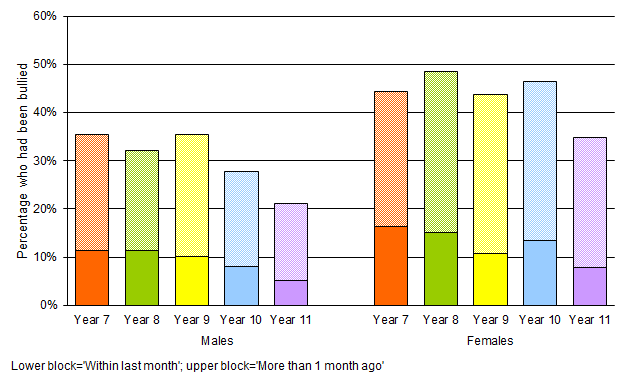
Young people living in the most deprived fifth of areas of Hull were more likely to have experience bullying in the last month compared to those living in the least deprived fifth of areas of Hull. The difference was particularly marked among girls where twice as many who lived in the most deprived fifth of areas of Hull stated they had been bullied in the last month compared to least deprived fifth (16% versus 7%).
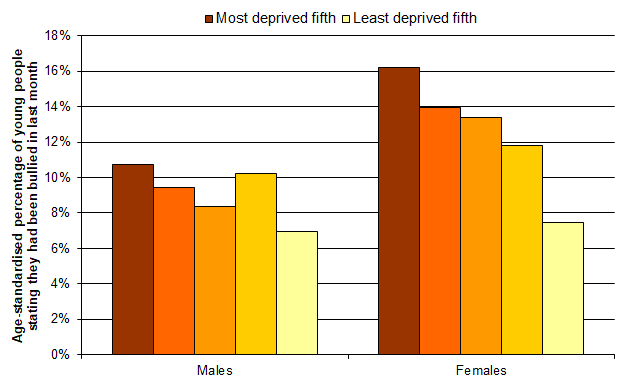
As well as bullying in the last month, young people were also asked if they had ever been bullied. There were relatively small differences when examining experience of having ever been bullying by deprivation, although the percentage was slightly lower among young people living in the least deprived fifth of areas of Hull (37% to 39% for most deprived four-fifths and 31% in least deprived fifth).
Being called names or teased had the highest percentage of young people stating that this had happened to them followed by having lies or rumours spread about you.
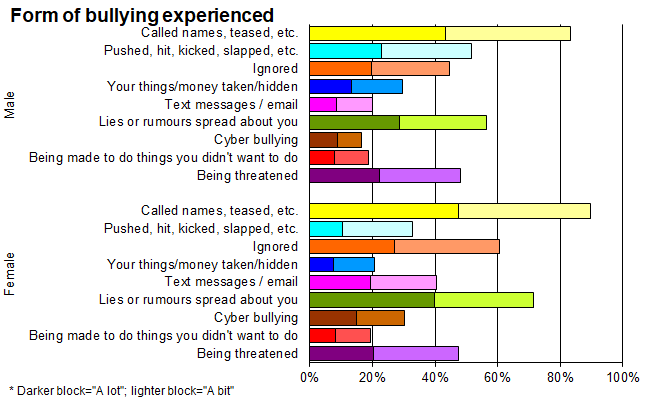
One in eight pupils (12.1%) had previously bullied someone else with 3.8% bullied someone else in the last month.
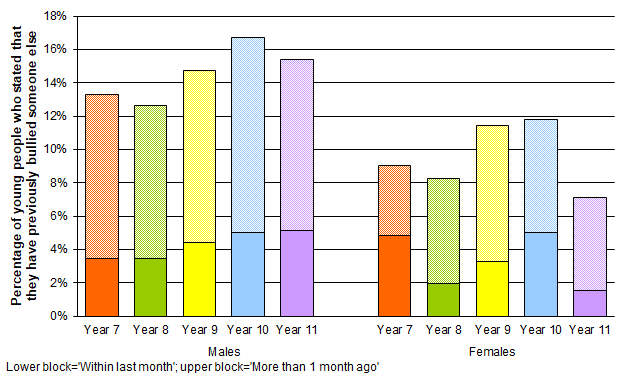
Mental Health of Children and Young People in England, 2017 survey
One in eight (13%) of those aged 5 to 19 years had at least one mental disorder when surveyed in 2017. Applying this to Hull’s population for 2023 (the most recent available population estimate) this would equate to 6,646 children and young people.
This includes (some children and young people can fall into more than one category):
- One in twelve (8%) had an emotional disorder such as anxiety, depression and/or low mood (equating to 4,188 children and young people in Hull).
- One in twenty (5%) had a behavioural (conduct) disorder (equating to 2,410 children and young people in Hull).
- One in fifty (2%) had a less common disorder such as Autistic Spectrum Disorder or an eating disorder (equating to 1,097 children and young people in Hull).
- One in sixty (2%) had a hyperactivity disorder (equating to 852 children and young people in Hull).
National Estimates of Poor Mental Health Applied to Hull
Nationally, the numbers of young people aged 15 year with mental health issues has been estimated for a classroom of 30 pupils.
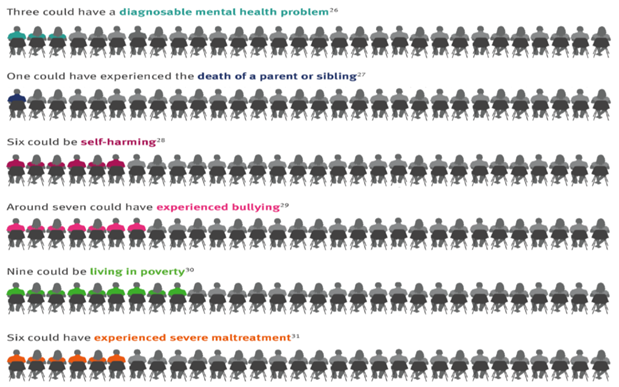
The most common disorder in early years and primary school are behavioural disorders and the most common in secondary school and post 16 establishments are emotional disorders. Early intervention is key to reducing this prevalence.
Prevalence is increasing both nationally and locally. There are also marked gender differences, for instance, older girls are more likely to experience emotional disorders.
The prevalence of mental ill health is higher amongst vulnerable groups of children and young people:
- LGBT+ young people are more likely to have a diagnosable mental health problem (34.9% compared to 13.2%).
- Mental health problems are more common in children living in lower income households (9% compared to 4.1%).
- Children living with a parent with poor mental health are the most at risk group.
- Over a third of 5 to 19 year olds with a mental health problem (35.6%) were also recognised as having special educational needs.
- School exclusions are more common in children with a mental health difficulty (6.8%) than those without (0.5%).
- Other risk factors include poor housing, being in or leaving care, being a young carer or experiencing bereavement.
The State of the Nation 2021 and 2022 Children and Young People’s Wellbeing Research reports, as well as NHS Digital’s Mental Health of Children and Young People in England survey in 2017 and four subsequent waves of follow-up surveys in 2020, 2021, 2022 and 2023, estimated the prevalence of probable mental disorders among children in England, and it is possible to use these estimates of prevalence and apply them to Hull’s population.
The Strengths and Difficulties Questionnaire was used and includes 25 questions on different aspects of behaviour related to emotional problems, conduct problems, hyperactivity/inattention (restlessness), peer relationship problems and positive prosocial behaviour. The responses to the four problem scales can be viewed together to assess a person’s total difficulties, or separately to look at particular problems. The scores for these scales can then also be combined with answers to questions about the impact that the difficulties have on the child’s life to create a score which indicates likelihood of that child having a mental disorder from unlikely to probable.
In 2023, they estimated that around 20% of children and young people aged 8-16 years have a probable mental disorder increasing to around 23% among young people aged 17-19 years and 22% among young people aged 20-25 years.
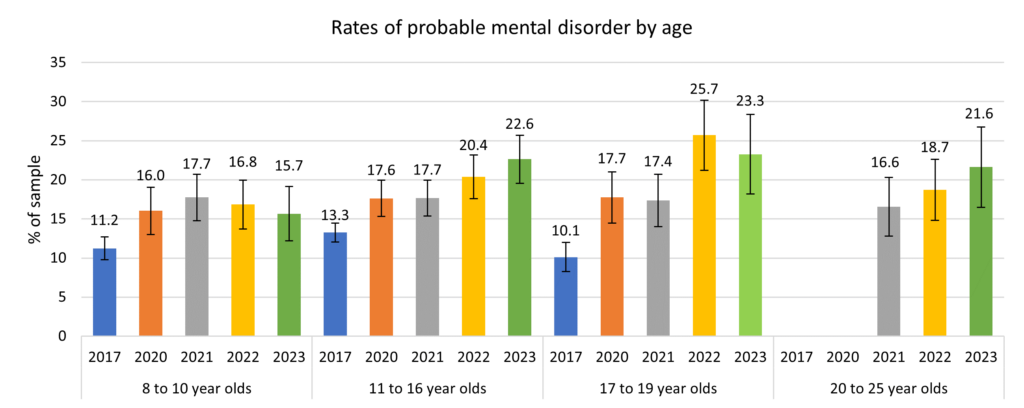
The report also gives the prevalence of probable mental disorder by age and gender. The prevalence is around 30% higher in boys compared to girls among those aged 8-10 years, similar for boys and girls aged 11 to 16 years, but around twice as high among young women aged 17-25 years than among young men of the same age.
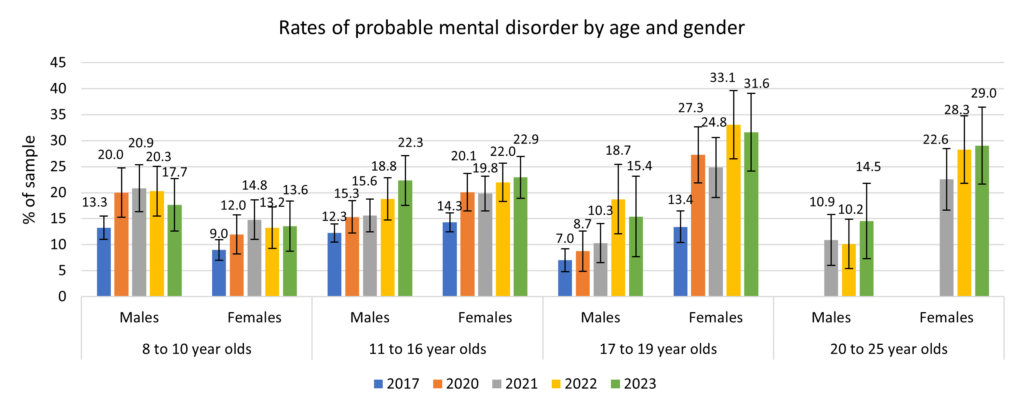
If these national prevalence estimates are applied to Hull’s population, then there would be 1,647 8-10 year olds, 4,723 11-16 year olds, 2,416 17-19 year olds and 4,585 20-25 year olds with probable mental disorders living in Hull.
| Age (years) | Males | Males | Females | Females | Persons |
| England, % | Hull, N | England, % | Hull, N | Hull, N | |
| 8-10 | 17.7 | 949 | 13.6 | 698 | 1,647 |
| 11-16 | 22.3 | 2,379 | 22.9 | 4,723 | 4,723 |
| 17-19 | 15.4 | 842 | 31.6 | 2,416 | 2,416 |
| 20-25 | 13.4 | 1,460 | 30.4 | 3,125 | 4,585 |
The State of the Nation 2022 report also gives the trends over time for England in relation to levels of happiness yesterday, satisfaction with life and extent young people feel the things they do in life are worthwhile. The charts below give the information for 10-17 year olds for England. Levels of happiness, satisfaction and feeling life was worthwhile have remained relatively consistent over time, although there is a fall in 2020 presumably due to the COVID-19 pandemic.
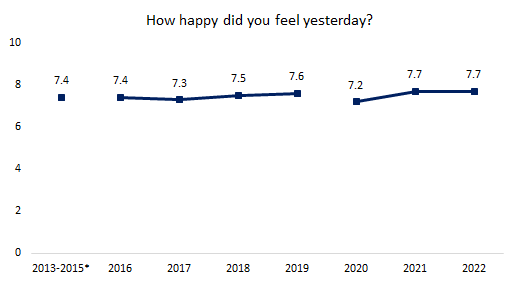
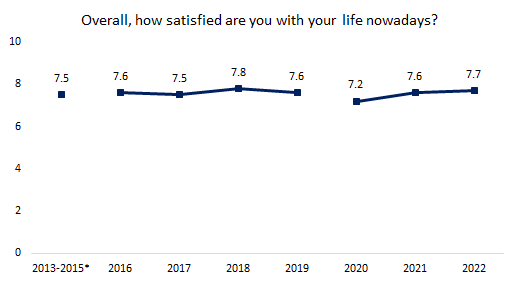
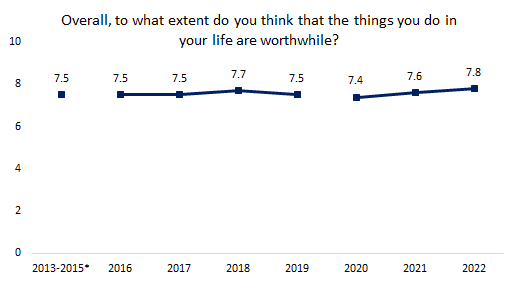
Looked After Children
Just under half of looked after children in Hull had levels of emotional wellbeing which was a cause for concern in 2023/24 which was higher than England and the region.
This relates to children aged 5-16 years at the date of their latest assessment who have been in care for at least 12 months on the 31 March of the year whose strengths and difficulties questionnaire (SDQ) score is 17 or more.
Compared with benchmark
| Indicator | Period | England | Yorkshire and the Humber region (statistical) | Kingston upon Hull | East Riding of Yorkshire | North East Lincolnshire | North Lincolnshire | York | North Yorkshire UA | Barnsley | Doncaster | Rotherham | Sheffield | Bradford | Calderdale | Kirklees | Leeds | Wakefield |
|---|---|---|---|---|---|---|---|---|---|---|---|---|---|---|---|---|---|---|
Percentage of looked after children whose emotional wellbeing is a cause for concern (Persons 5-16 yrs) | 2023/24 | 41.0 | 42.0 | 48.0 | 38.0 | 40.0 | 47.0 | 44.0 | 49.0 | 48.0 | 48.0 | 49.0 | 49.0 | 33.0 | 41.0 | 43.0 | 38.0 | 42.0 |
| Indicator | Period | England | Yorkshire and the Humber region (statistical) | Kingston upon Hull | East Riding of Yorkshire | North East Lincolnshire | North Lincolnshire | York | North Yorkshire UA | Barnsley | Doncaster | Rotherham | Sheffield | Bradford | Calderdale | Kirklees | Leeds | Wakefield |
|---|---|---|---|---|---|---|---|---|---|---|---|---|---|---|---|---|---|---|
Percentage of looked after children whose emotional wellbeing is a cause for concern (Persons 5-16 yrs) | 2023/24 | 41.0 | 42.0 | 48.0 | 38.0 | 40.0 | 47.0 | 44.0 | 49.0 | 48.0 | 48.0 | 49.0 | 49.0 | 33.0 | 41.0 | 43.0 | 38.0 | 42.0 |
There has been some year-on-year variation in the percentage of looked after children whose emotional wellbeing is a cause for concern, but for most years there has been no statistically significant difference in the percentage between Hull and England (except for 2018/19 when the percentage in Hull was significantly lower than England). However, in the last year the percentage has increased in Hull and for 2023/24, the percentage is statistically significantly higher than England.
Compared with benchmark
Percentage of looked after children whose emotional wellbeing is a cause for concern (Persons 5-16 yrs)
|
Period
|
Kingston upon Hull |
Yorkshire and the Humber region (statistical)
|
England
|
||||
|---|---|---|---|---|---|---|---|
|
Count
|
Value
|
95%
Lower CI |
95%
Upper CI |
||||
| 2015/16 | • | 39 | 39.0% | 30.0% | 48.8% | 39.1% | 37.8% |
| 2016/17 | • | 40 | 41.7% | 32.3% | 51.7% | 42.8% | 38.1% |
| 2017/18 | • | 41 | 46.1% | 36.1% | 56.4% | 42.7% | 38.6% |
| 2018/19 | • | 74 | 28.0% | 22.5% | 33.1% | 41.0% | 39.0% |
| 2019/20 | • | 134 | 38.0% | 33.2% | 43.2% | 40.0% | 38.0% |
| 2020/21 | • | 135 | 34.0% | 29.1% | 38.3% | 39.0% | 37.0% |
| 2021/22 | • | 140 | 34.0% | 29.6% | 38.7% | 39.0% | 37.0% |
| 2022/23 | • | 139 | 42.0% | 36.7% | 47.2% | 42.0% | 40.0% |
| 2023/24 | • | 189 | 48.0% | 43.3% | 53.2% | 42.0% | 41.0% |
Source: Department for Education
Presenting Issues for Local Young People
The main presenting issues for young people accessing Hull’s Targeted Early Help / Getting Help programme were as follows:
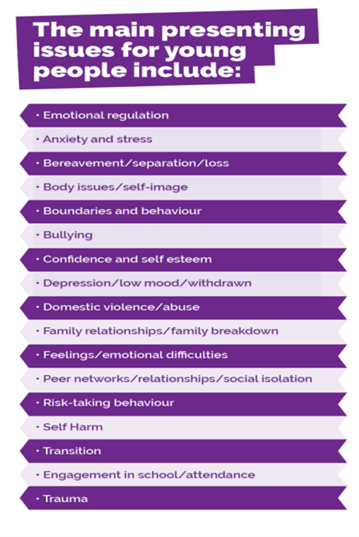
The main presenting issues for parents were as follows:
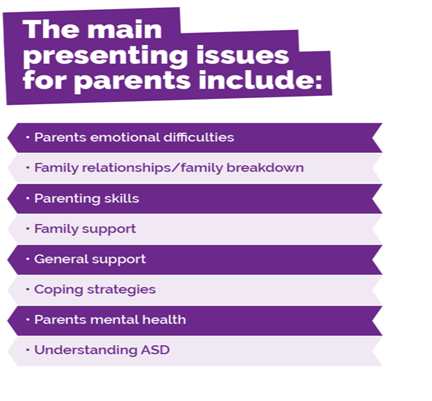
Impact of the COVID-19 Pandemic
Information relating to the impact of the COVID-19 pandemic on children and young people’s mental health is available at a national level, and it is probable that similar effects have occurred among Hull’s children and young people.
The State of the Nation 2021 and 2022 reports also give the trends over time for England for the 2020/21 and 2021/22 academic years among primary school pupils (aged 5-11 years) giving the parent-reported wellbeing ratings for happiness and anxiety.
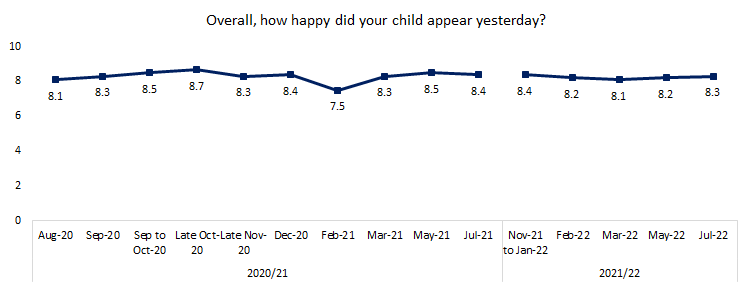
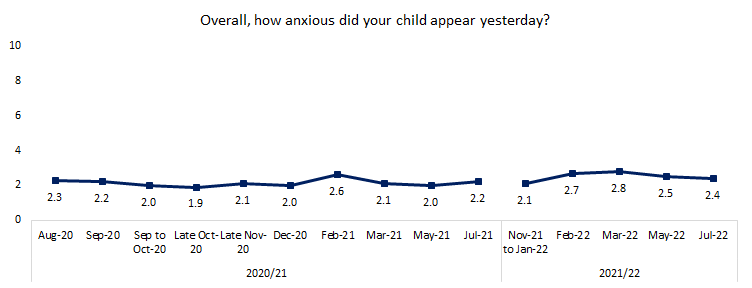
More detailed information is also available for the 2020/21 and 2021/22 academic years among English secondary school aged pupils (aged 11-18 years).
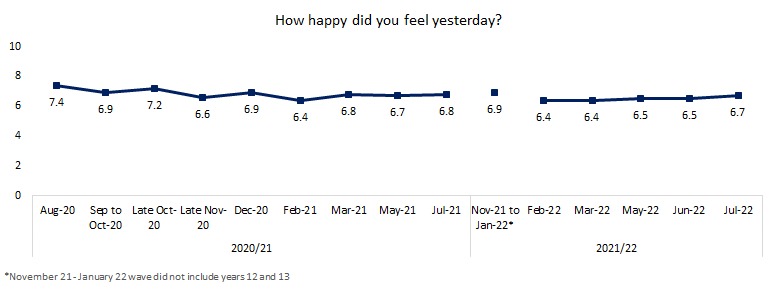
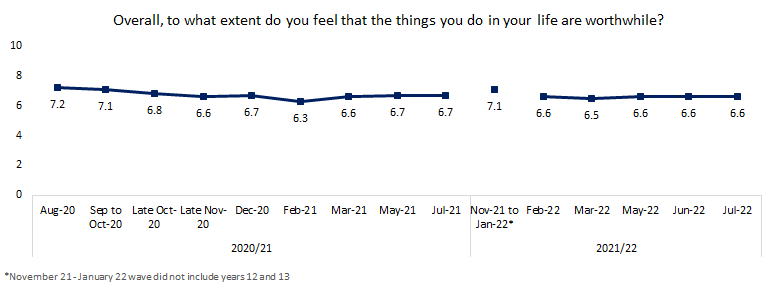
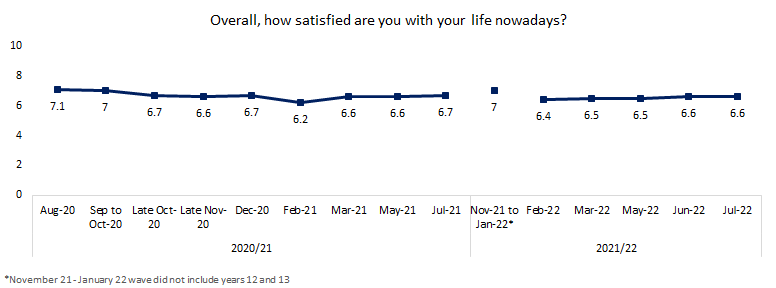
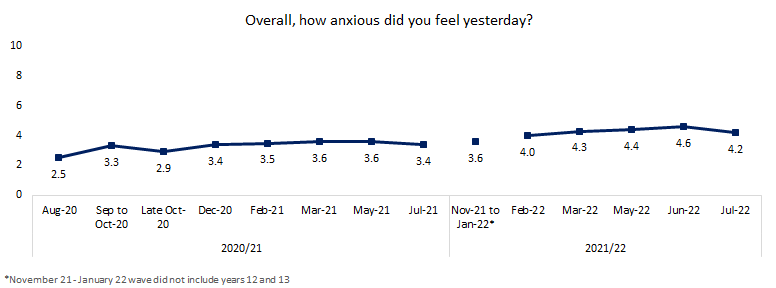
From the Health Foundation’s report into children and young people’s mental health and ‘COVID-19 and the road ahead’, they state that mental health conditions have become more common since the start of the pandemic. They estimate that between 2017 and 2021, the percentage of 6 to 16 year olds with a probable mental health conditi0n increased from one in nine (11.6%) to one in six (17.4%). They recognise that increased awareness and recognition of mental health conditions in children and young people may have contributed to the increase, but they indicate that the prevalence of mental heath conditions is likely increasing. Girls aged 17-19 years had the highest increases in prevalence almost doubling from one in seven (13.4%) in 2017 to one in four (24.8%) in 2021, but boys of the same age showed no statistically significant change over time. In 2021, children and adolescents with a probable mental health condition were twice as likely to live in households newly falling behind on bills (12.8%, compared with 6.7% of 6 to 16-year-olds without a mental health condition).
Their report also details the referrals into Children and Young People Mental Health Services (CYPMHS) for England. They state that the rate of new referrals to CYPMHS initially slowed after March 2020, when schools closed due to COVID-19 restrictions and families had to navigate changes in access to primary care. In April 2020, a month after the first lockdown started in England, new referrals were 35% lower than a year before and they did not recover to previous levels until July 2020. After this point, they rapidly accelerated and subsequently reached a record high of 100,000 new referrals per month in May 2021. They state that the data show encouraging signs that CYPMHS capacity has also expanded to treat an increasing number of children and young people, as shown by the number of first-time appointments for those younger than 18. In 2020, during the first COVID-19 wave, the number of first contacts initially slowed but later recovered to previous levels. In 2021, based on data from January to September, there were on average over 55,000 first contacts per month, an increase of 17% compared with the same period in 2020. According to NHS Digital monthly mental health statistics, over 340,000 children and young people were in contact with CYPMHS in July 2021, meaning they were waiting to commence treatment or currently receiving treatment – the highest number ever recorded. Comparing the period between January and September, the number of people in contact with CYPMHS was 24% higher in 2021 than in 2020, and 44% higher than in 2019. This increase is partly related to changes in reporting, with the number of providers submitting data increasing over time. They state that changes in reporting methodology have created additional challenges in determining the extent to which the CYPMHS caseload has increased.
Strategic Need and Service Provision
In order to improve mental health and wellbeing, WHO state that it is necessary to have an environment that supports mental health. National mental health policies should be concerned both with mental disorders and, with broader issues that promote mental health. Mental health promotion should be mainstreamed into governmental and nongovernmental policies and programmes. In addition to the health sector, it is essential to involve the education, labour, justice, transport, environment, housing, and welfare sectors.
Both adults and children with general mental health issues need to be identified early and encouraged to seek help early so that the consequences in terms of the effects on family, education and employment are minimised, and issues are not escalated so to reduce the need for crisis and/or medical interventions. It should be recognised that specific groups of people may be more likely to have mental health issues due to their circumstances, such as poverty, asylum seekers, social isolation. There is a need to improve and expand early help and targeted interventions to improve young people’s emotional health and wellbeing and build resilience to enable them to cope with challenging life events.
In 2018 NHS England set out its ten year long term plan for the priorities to be delivered for children and young people.
- Additional investment in community based mental health services.
- The creation of mental health support teams in schools and colleges.
- Safe places and crisis cafés open 24/7 to support young people.
- Home Intensive Treatment teams to support young people in their own home and the community to reduce the need for in patient beds.
- Additional investment into community eating disorder services and prevention and promotion offers.
Prevention and early intervention relating to children and young people in terms of the Thriving, Getting Advice and some aspects of Getting Help, encompass only part of the whole mental health system for Hull. More information on mental health and emotional wellbeing and early intervention is also available under Early Help and Prevention under Child Development within Children and Young People.
Hull has adopted the THRIVE Framework to describe and organise system efforts in relation to children and young people’s emotional and mental health. For more information on the Thrive Framework and an up-to-date list of services available to support children and young people’s emotional and mental health, mapped against the THRIVE model in Hull, please visit: https://www.howareyoufeeling.org.uk
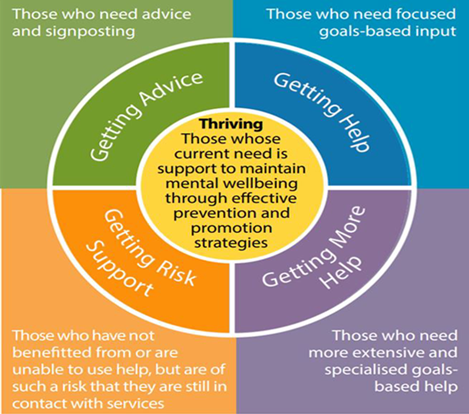
It is recognised the mental and emotional wellbeing has been detrimentally affected for many children and young people due to COVID-19 and lockdowns. Furthermore, the effect has not been felt evenly across society and the most vulnerable have generally been affected the worst, increasing the inequalities gap. Recognition is not sufficient and increased resources need to be made available to improve mental health and emotional wellbeing in children and young people.
A Mentally Healthy Hull strategy has been produced which looks at how, as a city, we can collectively boost good mental health and prevent and reduce the impact of mental health problems.
Resources
National Institute for Health and Care Excellence, Social and emotional wellbeing for children and young people: Local government briefing. www.nice.org.uk. 2013, National Institute for Health and Care Excellence: London.
World Health Organization. Mental health: strengthening our response: https://www.who.int/news-room/fact-sheets/detail/mental-health-strengthening-our-response
WHO Special Initiative for Mental Health (2019-2023): Universal Health Coverage for Mental Health. World Health Organisation, 2019. https://apps.who.int/iris/handle/10665/310981
Hull’s Young People Health and Wellbeing Survey
Mental Health of Children and Young People in England, 2017. Official statistics, survey. NHS Digital, November 2018.
Mental Health of Children and Young People in England, 2017 [PAS] – NDRS (digital.nhs.uk)
Mental Health of Children and Young People in England, 2023 – wave 4 follow up to the 2017 survey. https://digital.nhs.uk/data-and-information/publications/statistical/mental-health-of-children-and-young-people-in-england/2023-wave-4-follow-up
State of the Nation 2021: Children and Young People’s Wellbeing. Research report. Department for Education, February 2022. https://www.gov.uk/government/publications/state-of-the-nation-2021-children-and-young-peoples-wellbeing
State of the Nation 2022: Children and Young People’s Wellbeing. Research report. Department for Education, February 2023. https://www.gov.uk/government/publications/state-of-the-nation-2022-children-and-young-peoples-wellbeing
Strengths and Difficulties Questionnaire. https://www.sdqinfo.org/
The Health Foundation. Children and young people’s mental health. COVID-19 and the road ahead. https://www.health.org.uk/news-and-comment/charts-and-infographics/children-and-young-people-s-mental-health
NHS Digital. Mental Health Services Monthly Statistics. https://digital.nhs.uk/data-and-information/publications/statistical/mental-health-services-monthly-statistics
THRIVE Framework. https://www.annafreud.org/mental-health-professionals/thrive-framework/
How are you feeling today? THRIVE Hull. https://www.howareyoufeeling.org.uk/
Hull’s Early Help and Prevention Strategy 2021-25. https://www.hull.gov.uk/downloads/file/1726/Hull_Early_Help_and_Prevention_Strategy_2021_25.pdf
Updates
This page was last updated / checked on 20 May 2025.
This page is due to be updated / checked in October 2025.